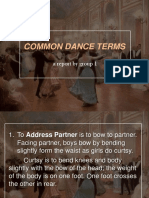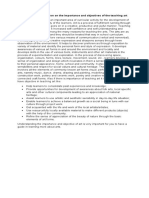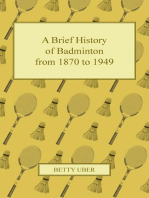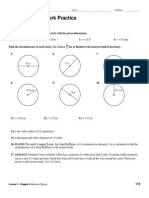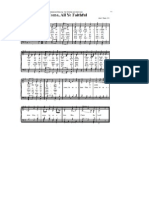Professional Documents
Culture Documents
Folk Dance
Folk Dance
Uploaded by
SideTrip SideKickOriginal Description:
Copyright
Available Formats
Share this document
Did you find this document useful?
Is this content inappropriate?
Report this DocumentCopyright:
Available Formats
Folk Dance
Folk Dance
Uploaded by
SideTrip SideKickCopyright:
Available Formats
Trisha Mae L.
Jaspe 12-Newton
Physical Education
1. WHAT IS FOLK DANCE?
Folk dance is a form of dance developed by a group of people that reflects the traditional life of a
certain country or region. Folk dancing represents the dance forms of the common people as opposed
to those from the upper classes. Generally, it is a type of dance that is a vernacular, usually recreational,
expression of a past or present culture. The term folk dance was accepted until the mid-20th century,
when this and other categories of dance were questioned and their distinctions became subject to
debate.
2. EXAMPLES OF FOLK DANCE
1. Itik-Itik
The Itik-Itik is a dance from Surigao del Norte, in which the movements of a duck are imitated. An itik is
a species of duck. According to popular tradition, the dance was created by a lady named Kanang who
choreographed the steps while dancing at a baptismal party. The other guests copied her movements,
and everyone liked the dance so much that it has been passed along ever since.
2. Tinikling
Tinikling means "bamboo dance" in English. The dance imitates the movement of the tikling birds as
they walk between grass stems, run over tree branches, or dodge bamboo traps set by rice farmers.
Dancers imitate the tikling bird's legendary grace and speed by skillfully maneuvering between large
bamboo poles.
3. Maglalatik
Maglalatik was originally performed in Biñan, Laguna as a mock-war dance that demonstrates a fight
between the Moros and the Christians over the prized latik or coconut meat during the Spanish rule, this
dance is also shown to pay tribute to the town’s patron saint, San Isidro Labrador.
4. Kuratsa
The Kuratsa is highly favored by the Waray people of the Eastern Visayan region in the Philippines.
Strictly speaking, The Kuratsa must be done the amenudo; that is, only one couple dances it at a time.
the Kuratsa is however, very different in the manner of execution to the Mexican counterpart.
5. Makonggo
It is a comic dance from Santa Maria, Bulacan. Makonggo is derived from the Tagalog word chonggo or
unggo which means monkey. In this dance, the dancer imitates a monkey - its characteristic movements,
gestures, grimaces, etc. when it is in a happy, playful or angry mood, while it is playing, eating, or
resting. Only one man performs this dance. Most of his movements are his own improvisations.
3. COMMON DANCE STEPS OF PHILIPPINE FOLK DANCE
1. Bacui Step 2. Bleking Step
Music: ¾ time. Counts 1, 2, 3. Music: 2/4 time. Counts 1,2.
3. Cross Waltz 4. Cut Step
Music: ¾ time. Counts 1, 2, 3. Music: 2/4 time. Counts 1, 2.
Trisha Mae L. Jaspe 12-Newton
5. Engaño
Music: ¾ time. Counts 1, 2, 3.
4. COMMON DANCE TERMS OF PHILIPPINE FOLK DANCE
1. Bilao
Hands in front, parallel to each other at waist level, elbows close to the wrist, palms down. Reverse the
position of the hands with palms up and down alternatively.
2. Cross-Over
Two couples are opposite each other. Each couple proceeds toopposite place, the Girls pass by their L
shoulders between the Boys. Boys bow to each other when they meet at the middle, then follow the
Girls to the opposite place. Partners turn right about upon reaching the opposite place. Girls stand at
partners' right side.
3. Kumintang
Moving the hand from the wrist either clockwise or in counter clockwise direction. This is an Ilocano
dance term.
4. Masiwak
To turn the hand from the wrist half-way clockwise then raise and lower wrist once or twice. This is an
Ibanag dance term.
5. Panadyak
With body weight on L (R) foot, stamp R (L) foot in 4TH. In front, then tap same foot close to L (R), arms
in reverse "T" position, hands doing the "kumintang" on the stamp.
5. HOW ARE YOU GOING TO EXECUTE THESE DANCE STEPS AND DANCE TERMS?
With the complexity of each folk dance, one must realize that upon executing the step, the past will
always be relived. Execution of these step aren’t like any other dances one occasionally encounter.
However, with proper guidance, I would definitely do my best to properly execute the steps that are
involved in the precious folk dances. Proper execution is accompanied by the words respect, discipline,
and confidence.
6. IS PERFORMING FOLK DANCE IMPORTANT TO YOU AS A GRADE 12 STUDENT? WHY?
Folk dance is a reflection of our culture and tradition and the life of our ancestors in the past centuries.
It embraces our own national identity and embodies us as a Filipino. It is important to know and practice
them so that our culture and our tradition will be preserved.
You might also like
- P.E. (Chapter 2)Document43 pagesP.E. (Chapter 2)Nika SorianoNo ratings yet
- Forever Reign ChordsDocument2 pagesForever Reign ChordsCaleb WengerNo ratings yet
- Harmony in Mendelssohn and SchumannDocument293 pagesHarmony in Mendelssohn and Schumannjames_lao6453100% (6)
- ChanelDocument6 pagesChanelAndrew Arciosa CalsoNo ratings yet
- History of Physical Education in The PhilippinesDocument15 pagesHistory of Physical Education in The PhilippineszaiaNo ratings yet
- Leslie Ann O. Potenciano Bs Biology 1C PE3 Swimming: Pre-TestDocument10 pagesLeslie Ann O. Potenciano Bs Biology 1C PE3 Swimming: Pre-TestLeslie Ann PotencianoNo ratings yet
- Realization About NSTPDocument3 pagesRealization About NSTPLaurence CamasoNo ratings yet
- Visual, Auditory, and Kinesthetic LearnersDocument2 pagesVisual, Auditory, and Kinesthetic LearnersDiana Morilla AznaNo ratings yet
- Dance: Movement Organization Structure Pattern. Arrangement of Parts Into A FormDocument5 pagesDance: Movement Organization Structure Pattern. Arrangement of Parts Into A Formmichael mendozaNo ratings yet
- K-W-L Chart: Unit 1: The Path To Fitness and HealthDocument6 pagesK-W-L Chart: Unit 1: The Path To Fitness and HealthSheryl MaganNo ratings yet
- Physed 4Document16 pagesPhysed 4Eunizel Tagama AnchetaNo ratings yet
- Mazurka de Jagna RubricsDocument2 pagesMazurka de Jagna RubricsMary Fatima LlanesNo ratings yet
- PE 104 Notes - Final-1Document22 pagesPE 104 Notes - Final-1Cheryl GabianaNo ratings yet
- P.E 3 (Physical Education-Sports) : Learning Module # 5Document7 pagesP.E 3 (Physical Education-Sports) : Learning Module # 5Winefredo Quiapo PaghubasanNo ratings yet
- Bsed Englishi C2module6group2tcaDocument7 pagesBsed Englishi C2module6group2tcaJay Paul Casinillo100% (1)
- Senior High School Department Sy: 2019-2020Document26 pagesSenior High School Department Sy: 2019-2020Paopao MacalaladNo ratings yet
- Physical and Health EducationDocument14 pagesPhysical and Health EducationACERO, CHRISTIAN (ACERO, CHRISTIAN B.)No ratings yet
- 21 Stcentury EducationDocument14 pages21 Stcentury EducationNazar Danedogawa100% (1)
- Health Optimizing Physical Education 1Document52 pagesHealth Optimizing Physical Education 1Daisuke InoueNo ratings yet
- TSTRAT 11 HandoutsDocument4 pagesTSTRAT 11 HandoutsP. Harrison100% (1)
- U1 - L1 - Arts in The K-To-12 Curriculum PDFDocument7 pagesU1 - L1 - Arts in The K-To-12 Curriculum PDFJames Sanchez MangahasNo ratings yet
- What Is Assessment in Physical EducationDocument14 pagesWhat Is Assessment in Physical EducationCorteza, Ricardo Danilo E. UnknownNo ratings yet
- BIGNO PE 2-ImpressionDocument9 pagesBIGNO PE 2-ImpressionBiel AbistadoNo ratings yet
- Detailed - Lesson - Plan - For - Physical - Education 8Document8 pagesDetailed - Lesson - Plan - For - Physical - Education 8Sherwin TamayaoNo ratings yet
- Lesson 1:: Introduction To Physical EducationDocument17 pagesLesson 1:: Introduction To Physical EducationAngel Grace Asuncion100% (1)
- Week 7 Reflection FrisbeeDocument4 pagesWeek 7 Reflection Frisbeeapi-294958199No ratings yet
- Running Head: Literature Review 1Document6 pagesRunning Head: Literature Review 1Loise GakiiNo ratings yet
- Basketball A Brief HistoryDocument13 pagesBasketball A Brief HistoryKyle Gabriel DonesNo ratings yet
- Chapter 3Document9 pagesChapter 3Frankyl PazNo ratings yet
- Quiz: Video Analysis 1. What Is Scientism?Document2 pagesQuiz: Video Analysis 1. What Is Scientism?hiroshika wsabi100% (1)
- PH DanceDocument11 pagesPH DanceTrixie Nichole Garaña EspejoNo ratings yet
- Group 3 ConstructivismDocument20 pagesGroup 3 ConstructivismProgrammer AkoNo ratings yet
- History of Movement EducationDocument4 pagesHistory of Movement EducationMark FernandezNo ratings yet
- DancesDocument2 pagesDancesWilsonNo ratings yet
- Common Dance Terms: A Report by Group 1Document7 pagesCommon Dance Terms: A Report by Group 1Syhrel Dela Cruz0% (1)
- Unit Iii: Social DancesDocument42 pagesUnit Iii: Social DancesMaria LigayaNo ratings yet
- Learners - Materials - PE - 6 - 1st - Quarter - PDF - Filename - UTF-8''learners Materials - PE 6 1st QuarterDocument35 pagesLearners - Materials - PE - 6 - 1st - Quarter - PDF - Filename - UTF-8''learners Materials - PE 6 1st QuarterPhilipp Cutar100% (2)
- Write A1-Page Reflection On The Importance and Objectives of The Teaching ArtDocument1 pageWrite A1-Page Reflection On The Importance and Objectives of The Teaching Artchristine Joy MaraonNo ratings yet
- Unit II Physical FitnessDocument16 pagesUnit II Physical FitnessMark Angelo LoceriagaNo ratings yet
- Characteriz Ing Artistically Literate: IndividualsDocument16 pagesCharacteriz Ing Artistically Literate: IndividualsMarvin ManaloNo ratings yet
- Swimming For Recreation: Healthy Weight Heart LungsDocument2 pagesSwimming For Recreation: Healthy Weight Heart LungsJoycs PintoNo ratings yet
- Reviewer 2Document109 pagesReviewer 2Shiela P. ZumarragaNo ratings yet
- PE 103 DANCES Unit 5 Hip Hop DanceDocument5 pagesPE 103 DANCES Unit 5 Hip Hop DanceVictor Angelo AlejandroNo ratings yet
- PE2 Fundamentals of Rhythm and DanceDocument33 pagesPE2 Fundamentals of Rhythm and DancePiolo JazulNo ratings yet
- Engage: Please Refer To Module 2 Answer SheetsDocument17 pagesEngage: Please Refer To Module 2 Answer SheetsNastasha Ruth Hilado MiraflorNo ratings yet
- Chapter 3: Principles of Physical EducationDocument24 pagesChapter 3: Principles of Physical EducationyessodaNo ratings yet
- Designing Physical: Instruction For Education and HealthDocument22 pagesDesigning Physical: Instruction For Education and HealthChristine Mae CalfoforoNo ratings yet
- Ella Marie Mostrales - Activity 7Document8 pagesElla Marie Mostrales - Activity 7Ella Marie MostralesNo ratings yet
- Officiating Basketball and Referee Signals: There Are "Fouls" and There Are "Violations"Document8 pagesOfficiating Basketball and Referee Signals: There Are "Fouls" and There Are "Violations"Kristia Anagap100% (1)
- Reflection Paper Unit 2Document4 pagesReflection Paper Unit 2Andres, Katrina Michelle R.No ratings yet
- Movement Enhancement: Prepared: Angelica M. Magdaong Instructor Angelica - Magdaong@cvsu - Edu.phDocument14 pagesMovement Enhancement: Prepared: Angelica M. Magdaong Instructor Angelica - Magdaong@cvsu - Edu.phAileen Dalian CristolesNo ratings yet
- Physical Foundation1Document4 pagesPhysical Foundation1amee flor b. relletaNo ratings yet
- Movement QualitiesDocument18 pagesMovement QualitiesAlondra L. FormenteraNo ratings yet
- Module 8Document10 pagesModule 8CanhgNo ratings yet
- A Brief History of Badminton from 1870 to 1949From EverandA Brief History of Badminton from 1870 to 1949Rating: 3.5 out of 5 stars3.5/5 (2)
- My Life Journey Through . . . with God: Reality and Facts of Life!From EverandMy Life Journey Through . . . with God: Reality and Facts of Life!No ratings yet
- Traditional Folk DancesDocument10 pagesTraditional Folk Dancesgabrielbaldovino12No ratings yet
- FOLKDANCEDocument46 pagesFOLKDANCEJansen ValdezNo ratings yet
- ShaneDocument7 pagesShaneAlvin Jay Anatalio100% (1)
- Folk DanceDocument23 pagesFolk DanceAngilene BaruadoNo ratings yet
- SingkilDocument7 pagesSingkilShelly Dawn Bay-an0% (2)
- Folkdanc 2Document10 pagesFolkdanc 2Kathy SarmientoNo ratings yet
- Hyperbolic and Inverse Hyperbolic Functions (Slides)Document20 pagesHyperbolic and Inverse Hyperbolic Functions (Slides)SideTrip SideKickNo ratings yet
- English 13 ReadingsDocument24 pagesEnglish 13 ReadingsSideTrip SideKickNo ratings yet
- Math 17 Samplex1Document4 pagesMath 17 Samplex1SideTrip SideKickNo ratings yet
- Cell AnalogyDocument13 pagesCell AnalogySideTrip SideKickNo ratings yet
- Math 17 Samplex1Document4 pagesMath 17 Samplex1SideTrip SideKickNo ratings yet
- Contemporary ArtsDocument2 pagesContemporary ArtsSideTrip SideKick100% (1)
- The Secret Art of Hypnotic WritingDocument18 pagesThe Secret Art of Hypnotic WritingAz4lifeNo ratings yet
- Analytic and Comparative Study of Francisco Tárrega S Two Volumenes of Guitar StudiesDocument24 pagesAnalytic and Comparative Study of Francisco Tárrega S Two Volumenes of Guitar Studiesonyxperidot50% (2)
- Amar Sonar BanglaDocument4 pagesAmar Sonar BanglaAliNo ratings yet
- Exercícios Com o Present SimpleDocument10 pagesExercícios Com o Present SimpleJosé SerraNo ratings yet
- Melodyne 5 Studio Reference Manual, Cubase 11 and Nuendo, EnglishDocument216 pagesMelodyne 5 Studio Reference Manual, Cubase 11 and Nuendo, EnglishNey ArtNo ratings yet
- BACKDocument1 pageBACKJohanna Grace AlvarezNo ratings yet
- 17 - How To Use A Noise GateDocument1 page17 - How To Use A Noise GateChromaticaNo ratings yet
- Artifact 3 FullDocument2 pagesArtifact 3 Fullapi-2397891340% (2)
- Reason - Autumn in My HeartDocument5 pagesReason - Autumn in My HeartRosya Prilia ChairaniNo ratings yet
- Logic Games For Young Learners03 Key Games Reading Comprehension Exercises 32896Document4 pagesLogic Games For Young Learners03 Key Games Reading Comprehension Exercises 32896a2305No ratings yet
- Mapeh WK1Document12 pagesMapeh WK1Elle QuizonNo ratings yet
- Movie 11, Nanatsu No Umi Wo Wataru Kaze No YouniDocument2 pagesMovie 11, Nanatsu No Umi Wo Wataru Kaze No YouniAbigail PheiliaNo ratings yet
- Answer Key: Unit 1 Grammar Worksheet ADocument4 pagesAnswer Key: Unit 1 Grammar Worksheet Aprado22No ratings yet
- Lamb of God FloresDocument2 pagesLamb of God Floresmarkgil salvatierraNo ratings yet
- Shotaro Matsumoto Resume 2Document2 pagesShotaro Matsumoto Resume 2api-325013371No ratings yet
- Xmas SongbookDocument18 pagesXmas SongbookAdam De Glasse0% (1)
- Manual Aplificador Nad C325beeDocument2 pagesManual Aplificador Nad C325beeFranklin SalasNo ratings yet
- 1000 câu chuyên đề viết lại câu tiếng anhDocument56 pages1000 câu chuyên đề viết lại câu tiếng anhHoàng BùiNo ratings yet
- BBC Time and Tune Wind in The WillowsDocument24 pagesBBC Time and Tune Wind in The WillowsJeremy VinesNo ratings yet
- Begin The Beguine - Tonight Show (Arr - Bill Holman) 63p Parts TranscriptionDocument63 pagesBegin The Beguine - Tonight Show (Arr - Bill Holman) 63p Parts TranscriptionJosué Kujat100% (1)
- The French Art Song Style in Selected Songs by Charles Ives: Scholar CommonsDocument68 pagesThe French Art Song Style in Selected Songs by Charles Ives: Scholar CommonsFamigliaRussoNo ratings yet
- Communion: Title Composer/Arranger Page #Document7 pagesCommunion: Title Composer/Arranger Page #Jeiam JavierNo ratings yet
- Repertoire List For WebsiteDocument11 pagesRepertoire List For Websiteapi-491303976No ratings yet
- 8 Key Cultural Differences Between Latinas and Women From Other CulturesDocument15 pages8 Key Cultural Differences Between Latinas and Women From Other CulturesEsteban Lara Á100% (2)
- 17. ĐỀ SỐ 17Document14 pages17. ĐỀ SỐ 17Thu PhươngNo ratings yet
- Musicality in TheatreDocument320 pagesMusicality in TheatreOlya Petrakova100% (6)
- Weill How-FarDocument3 pagesWeill How-FarJosé Ignacio BustamanteNo ratings yet


































